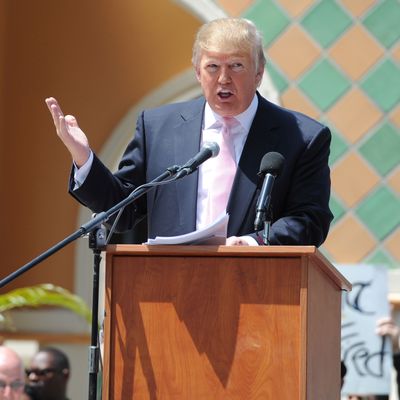
This week, largely drowned out on the stump by his succession of own goals, Donald Trump returned to a theme he has mentioned before in the campaign — his infrastructure plan, which would amount to either half a trillion dollars or a trillion dollars, depending on what day it is. Among the majority of Republicans who support Trump, this spending plan has provoked not a whimper of complaint. Among the minority who don’t like Trump, the irony is bitter. “If you ignore the rhetorical flourishes and stick to what he is actually advocating and how he proposes to pay for it you can call it by another name: stimulus,” writes anti-Trump conservative Jonathan Tobin. “So the question for Trump acolytes who now pose as the arbiters of what it means to be a conservative, what is it about Trump’s stimulus that [makes] it more acceptable to Republican voters than Obama’s?”
Why, that is quite a puzzle, isn’t it? The entire Republican Party treated Obama’s stimulus as a threat to the Republic, yet has said nothing as Trump has embraced a proposal with equally objectionable features. Tobin does not offer up an explanation for such a curious state of affairs, concluding only, “I’ve yet to hear a rational explanation for that fact.” Tobin is not alone in his incredulity. Conservative intellectuals who oppose Trump frequently deride him as a liberal, pronouncing his success at winning over conservative voters baffling. “Trump has talked repeatedly about favoring something like single-payer healthcare and the Obamacare mandate … The man doesn’t have a limited-government bone in his body,” wrote RedState’s Dan McLaughlin several months ago. In January, the conservative talk-show host Steve Deace ran through a long list of Trump ideological deviations and asked, “So why are some conservatives still defending this typical New York City liberal?” Again, he suggested no theory of the case. The question was the last line of the column.
Unlike the conservatives baffled at the voters’ acceptance of their nominee’s heresies, I do have an explanation. The overwhelming majority of Republican voters found Obama’s stimulus unacceptable for reasons that had nothing to do with its merits. Indeed, the same can be said of a large share of Obama’s entire domestic agenda, against which Republicans have spent eight years in a frenzy of opposition.
According to the official Republican history of the Obama administration, conservatives rose up in indignant protest against the administration’s radical left-wing agenda. Tobin repeats this well-worn version of events, reminding his readers, “opposition to Obama’s stimulus was, as much as the administration’s push for ObamaCare, the driving force behind the creation of the Tea Party in 2009 and 2010.” It is true that conservative elites believe, as Tobin does, that the stimulus did nothing to help the economy. (This belief is in contrast to the consensus of macroeconomic forecasters and economists.) But conservatives did not believe that fiscal stimulus can’t help a depressed economy until Obama took office. When the economy showed signs of sputtering in early 2008, Congress passed a fiscal stimulus by overwhelming margins (81-16 in the Senate, 380-34 in the House).
With the economy in utter collapse a year later, the economic case for stimulus had grown exponentially stronger — in fact, if there was only one time over the last three-quarters of a century when a Keynesian remedy was needed, early 2009 was it. But at this moment, Republican support for Keynesianism collapsed. Likewise, Mitt Romney ran for president in 2008 advocating what became Obamacare — regulated exchanges with subsidies and an individual mandate — and faced hardly any blowback from his base. John McCain ran as an advocate of cap and trade. But once Obama embraced those ideas, the entire party, including Romney and McCain, turned against them.
It’s a matter of public record that Republican leaders decided even before Obama took office that their path to power lay in total and immediate opposition to his agenda. Marshaling this extraordinary level of antipathy drove the conservative movement to the ideological right. The new Randian-inflected GOP believed Keynesian economics was now a complete fraud, Romney’s health-care plan mounted an unprecedented assault on the Constitution, McCain’s climate proposal was now a socialist monstrosity, and so on.
The rise of the tea party occurred in tandem with this new spirit of ideological purity within the movement. From the standpoint of the conservative movement’s elites, the two phenomena were one and the same. But the truth is that the freaked-out Republicans in America, watching Fox News in their Barcaloungers, were not animated by newfound appreciation for Rand and Hayek. As careful studies of the tea-party movement revealed, what animated Republican voters was a fear of cultural change. Their anti-statism was confined to programs that seemed to benefit people other than themselves. Racial resentment and ethnocentrism, not passion for limited government, drove the conservative base.
Almost alone within the party, Trump understood this. That is why his comically long list of ideological deviations never hurt him. Trump’s racism demonstrated to most Republican voters that he stood with them on the essential divide that ordered their political world — one defined by identity more than ideology.
In the conservative elite’s imagination, the romanticized history of the tea-party revolt — a story of liberty-loving Americans rising up against Big Government excess — still prevails. It is a story that attributes the party’s extraordinary opposition to the president’s policies, not to the primal fears he aroused. Trump has not only disproven the conservative movement’s theory of its own base. He’s disproven its history of the Obama presidency.






























